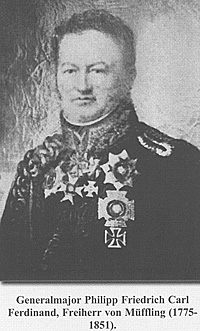Left Wing History (4):
Waterloo 1815
Von Muffling
by Gary Cousins, Germany
| |
“…a matter of perfect indifference to history…” ? Müffling, stationed on the left wing to co-ordinate the arrival of Zieten’s Prussians, wrote three 1815 accounts, which might be expected to shed light on matters. His 1816 history of the campaign said: Generalmajor Philipp Friedrich Carl Ferdinand, Freiherr von Müffling (1775-1851). “On the left wing towards Papelotte, it had been observed, that the enemy’s efforts were directed against the centre. To reinforce it, a message was sent to the 1st
Prussian corps expected from Ohain, requesting it
to hasten its march upon Papelotte. It was settled,
that as soon as that corps appeared on the rise
between Papelotte and Ohain, the cavalry brigades
of Vandeleur and Vivian should move off to reinforce
the centre. This was accordingly done” [38]
This arrangement was clearly made when
Zieten’s Corps was not yet in sight, but Müffling did not say by whom, and its wording
suggests some defensiveness. However, in his
memoirs, written in 1844 and published in
1851, Müffling elaborated:
“From my station at Papelotte, I could
overlook the advance of the enemy's reserve
from La Belle Alliance against the Duke's
centre; and as the advanced guard of the 1st
corps (General von Zieten) had already appeared
in the position on the nearest height, I
begged Generals Vandeleur and Vivian to
hasten immediately with their six regiments of
English cavalry to the assistance of the distressed
centre. On account of the arrival of the
Prussian corps they were no longer wanted on
the left wing. These regiments marched off,
and reached the centre in good time to make
some brilliant charges.” [39]
And in a letter to Hofmann, published in
1849, Müffling went further:
“Towards the time when General Zieten
with his corps was able to arrive, the Duke had
General Müffling told that he was steadfastly
holding the position of the right wing with
infantry, but had the entire enemy cavalry
opposite this wing, and therefore requested a
reinforcement by the cavalry of his left wing,
as soon as Zieten’s arrival allowed this.
Oberst von Reiche [Zieten’s chief of
staff], who had hurried ahead of the advance
guard of Zieten’s Corps, met General Müffling,
in order to orientate himself over its
intervention. General Müffling stated to him
what was required…
The Oberst quickly understood
this and hurried back to implement it.
General Müffling now asked the generals
Vandeleur and Vivian to hurry with their cavalry
brigades behind the infantry away to the
right to the Duke, whom he informed of this
measure and of the arrival of Zieten.” [40]
The versions differ as to whether Zieten’s
Corps was yet visible when the cavalry on the
left moved, but in all three accounts its departure
is followed by Zieten’s “turnaround” on
the Ohain road (not mentioned in Siborne’s
History) and a late French advance against
Wellington’s far left.
Müffling, in his position on the left wing,
should have been told that Wellington and
Uxbridge wanted the cavalry posted there to
be released as soon as feasible, and it is also
possible that when Zieten’s troops eventually
appeared on the left, Müffling urged Vivian
and Vandeleur to move, although it is not clear
that he had authority to give any orders. However,
Siborne’s informants, including Vivian
and Vandeleur, did not mention Müffling having
a role in the movement at all; his Prussian
sources were largely published works, and of
Müffling’s accounts only the 1816 version
was available to him when he wrote History:
Müffling’s more personal claims appeared
only after Siborne’s death.
Thus Müffling does not feature in this episode in History.
In the year that History was published in
German in 1846, Müffling added a note to his memoirs:
“This march of the brigades of Vandeleur
and Vivian from the left wing to the centre of
the English line of battle, is very correctly
described, as far as regards time, occasion,
and execution, in the report of the battle by the
English Captain Siborne. But the author has
been misinformed as to who gave directions
for this movement. I should certainly make no
mention of this circumstance (for it is a matter
of perfect indifference to history, whether A
or B issued the order), were not my report of
the battle, which was written years before the
appearance of Siborne's work, thereby exposed
to being censured as inaccurate.
Captain Siborne appears not to have been
the least aware that in the position I held with
the Duke of Wellington, I was stationed on his
left wing, nor to have heard what charge I had.
I never heard anything of an independent
movement on the part of General Vivian…” [41]
But Müffling did not challenge Siborne
directly and demand a revision for the 3rd
edition of History in 1848.
Among Siborne’s other Prussian sources
were works by Wagner and Damitz. Neither
mention Müffling’s personal claims: Damitz
stated (probably based upon Müffling’s 1816
work) that Uxbridge ordered the light cavalry
from the left wing to the centre as soon as
Zieten’s I Corps arrived; while Wagner at one
point stated that Uxbridge ordered this during
the French cavalry attacks, but elsewhere that Wellington gave the order just before the final
French advance. [42]
At this point, we might look at the statements by Uxbridge (and his staff).
Left Wing History (4) Vivian’s 6th (Light) Cavalry Brigade on the 18th June 1815
Left Wing History (3) Vivian’s 6th (Light) Cavalry Brigade on the 18th June 1815
Left Wing History (2) Prussian I Corps
Left Wing History (1) Waterloo 1815: Vivian's 6th Cavalry Brigade
|
